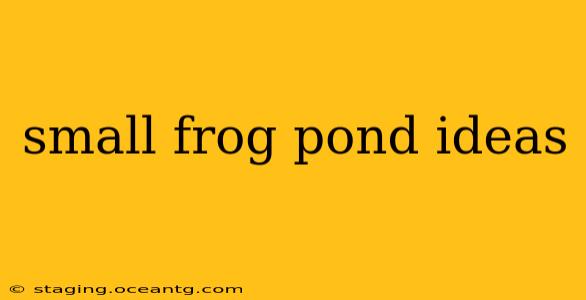Are you dreaming of a tranquil haven teeming with life, right in your backyard? A small frog pond can be the perfect addition to your garden, offering a captivating ecosystem and a beautiful focal point. But building a successful miniature pond requires careful planning and consideration. This guide explores various small frog pond ideas, addressing common questions and providing practical tips for creating a thriving habitat.
What Size Pond Do I Need for Frogs?
The size of your pond depends largely on the type of frog you plan to attract and the number you wish to support. While a tiny container might temporarily house a tadpole, a truly successful frog pond needs to be large enough to sustain adult frogs and their needs. A minimum size of roughly 2 feet by 2 feet and at least 1 foot deep is recommended. This provides ample space for swimming, basking, and hiding. Remember, a larger pond will support a more diverse and robust ecosystem.
What Plants Should I Put in a Small Frog Pond?
The right plants are crucial for providing shelter, oxygenating the water, and creating a natural environment for your frogs. Consider these options:
- Marginal Plants: These grow at the water's edge, offering excellent hiding places and basking spots. Look for species like Water Irises, Pickerelweed, or Arrowhead.
- Oxygenating Plants: Crucial for maintaining water quality, these plants help prevent algae blooms. Examples include Hornwort, Anacharis, and Elodea.
- Floating Plants: These provide shade and additional shelter. Duckweed and Water Lilies are popular choices, but keep in mind that some varieties can spread rapidly, so choose carefully.
Avoid using treated wood or other potentially toxic materials near your pond.
How Deep Should a Small Frog Pond Be?
A depth of at least one foot is essential. This allows for cooler water layers that frogs can utilize during warmer months and protects eggs and tadpoles from predators. Shorter depths in some areas can provide shallower basking spots for adult frogs. Varying the depth helps increase the biodiversity of your pond.
What Kind of Frogs Live in Small Ponds?
Many frog species can thrive in relatively small ponds, depending on your geographic location. Research the native frog species in your area to determine which ones are best suited to your climate and pond size. Some common pond frogs include:
- Green Frogs: Known for their vibrant green skin and large size.
- Bullfrogs: Larger than green frogs, requiring a larger pond, and potentially more resources.
- Tree Frogs: May utilize your pond for breeding, but may also spend significant time outside the water.
Remember, always prioritize native species to avoid introducing invasive species that could harm your ecosystem.
Do I Need a Filter for a Small Frog Pond?
A filter isn't strictly necessary for a small frog pond, particularly if you keep the pond well-maintained and avoid overfeeding any other pond inhabitants. However, a small, simple filter can help keep the water clearer and healthier, particularly if you have fish in the pond alongside your frogs. Overly powerful filters can be detrimental, disrupting the natural balance of the pond environment.
How Do I Keep Mosquitoes Out of My Small Frog Pond?
While frogs themselves are beneficial in controlling mosquito populations, you can take additional steps to minimize mosquito breeding:
- Introduce Mosquito-Eating Fish: Gambusia affinis (mosquitofish) are effective mosquito larvae predators.
- Regular Pond Maintenance: Remove any stagnant water or debris where mosquito larvae can breed.
- Use Natural Predators: Encourage dragonflies and other mosquito-eating insects to visit your pond.
Remember to research the environmental impact of any methods you choose to ensure they don't harm other pond inhabitants.
How Much Does it Cost to Build a Small Frog Pond?
The cost can vary widely depending on the size, materials used, and whether you build it yourself or hire a professional. You can create a basic pond for under $100 using readily available materials like a plastic container or repurposed items. More elaborate designs, using natural stone or pre-formed ponds, will cost more.
Creating a small frog pond is a rewarding project that brings beauty and life to your outdoor space. By considering these factors and planning carefully, you can create a thriving habitat that benefits both your garden and the local wildlife. Remember to research the specific needs of the frog species in your region to ensure their success and well-being.
